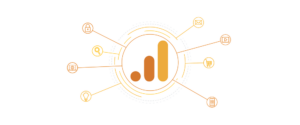June 3, 2022 / Thought Leadership
The Next Chapter of Google Analytics: Preparing for Google Analytics 4 (GA4)
Brian Kastelein, Director of Data & Analytics

So it’s official. On March 16, 2022, Google announced their intention to sunset the current version of Google Analytics, called Universal Analytics (UA), that has been the go-to web analytics tool for more than 30 million websites for the past 10 years. It will be replaced by a completely new Google Analytics environment, called Google Analytics 4 (GA4), by July 1, 2023.
Should you care? Absolutely! Google Analytics 4 will usher in an entirely new era of web analytics that moves away from a dependence on cookies, a tracking mechanism that has come under scrutiny in recent years as concerns over consumer privacy, along with corresponding legislation, have gained traction. In Google’s own words, GA4 is “privacy-centric by design, so you can rely on Analytics even as industry changes like restrictions on cookies and identifiers create gaps in your data.”
In my August blog post, “10 Things to Know About Google Analytics 4 (GA4),” I said the launch of GA4 was a BIG deal. Now with the deadline of July 1, 2023 clearly in view, it is an even BIGGER deal and organizations need to begin to prepare for what will be a major shift in website measurement and marketing campaign tracking.
Start using Google Analytics 4 immediately
Google is making every effort to ensure that no one is caught off guard. For anyone using Google Analytics with some regularity, you’ve no doubt received multiple emails, in addition to the now persistent reminder of the approaching deadline in the blue alert bar across the top of your Google Analytics account every time you log in.
Now is the time to heed that alert bar. There are ample technical considerations in planning the migration from UA to GA4. Everything from how to best export, store, and reference historical UA data to determining how to most effectively leverage new GA4 standards and functionality for event tagging, UTM conventions, and attribution models will need to be reviewed and configured in order to adapt to the new environment.
If you haven’t done so already, I strongly recommend setting up your GA4 property and running it in parallel to your existing UA account(s). This will allow data to begin to be collected in GA4 and provide a launching point for gaining familiarity with the new environment and exploring the many differences when comparing it to UA.
Begin to climb the steep learning curve
Beyond the technical considerations of GA4, one of the biggest challenges to be faced over the coming months is to effectively communicate to a more general and non-technical marketing audience the various impacts and implications of the shift from UA to GA4.
Complicating factors abound – and it’s going to require dedicated time, as well as a concerted effort, to navigate the UA to GA4 transition.
For instance, there is a “session” metric in both UA and GA4, however, the methodology for calculating a session in the two platforms is completely different making any year-over-year comparisons of “sessions” a bit like apples and oranges. By contrast, other standard metrics in UA, such as “bounce rate,” go the way of the dinosaurs and are replaced by new metrics, in this case “engagement rate,” in GA4.
Explaining these often nuanced differences to time-pressed and results-oriented marketing professionals, who don’t have a high tolerance for having caveats attached to their performance metrics, is going to have to be done methodically and incrementally. But the reality of a move to GA4 is that there are going to be inherent challenges to conducting cross-platform trend analysis and setting benchmarks based on historical performance levels. GA4 is truly a brand new world.
So with plenty of hurdles ahead, the upcoming months will be a true test of organizational fortitude. All marketers, from the more technical to the more creative, will need to collaborate and communicate to successfully navigate the transition to GA4. We are on the steep part of the learning curve, but the potential reward of mastering what will likely prove to be a more robust solution built for the impending cookie-less future must serve to motivate our efforts moving forward.
It’s yet another interesting chapter for modern marketing.
Check out Brian’s article published in Siliconrepublic.com.
 brief us?
brief us?





